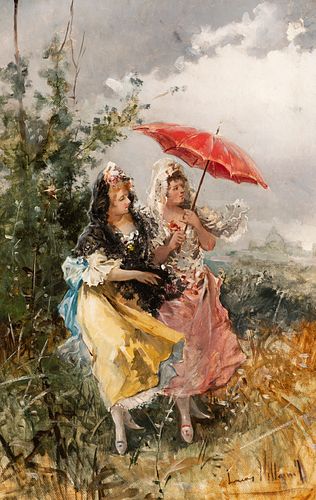EUGENIO LUCAS VILLAMIL (Madrid, 1858 - 1918). "Majas". Oil on canvas.
Lot 64
About Seller
Setdart Auction House
Carrer Aragó 346
Barcelona
Spain
Setdart Subastas was born in 2004 and is currently the first online art auction in Spain with solidity, prestige and reliability guaranteed by our more than 60,000 users. Setdart has a young, dynamic and enterprising team ready to successfully manage the purchase and sale of art works through custom...Read more
Estimate:
EUR€3,000 - EUR€3,500
$3,225.81 - $3,763.44
Absentee vs Live bid
Two ways to bid:
- Leave a max absentee bid and the platform will bid on your behalf up to your maximum bid during the live auction.
- Bid live during the auction and your bids will be submitted real-time to the auctioneer.
Bid Increments
| Price | Bid Increment |
|---|---|
| EUR€0 | EUR€10 |
| EUR€200 | EUR€25 |
| EUR€500 | EUR€50 |
| EUR€1,000 | EUR€100 |
| EUR€3,000 | EUR€200 |
| EUR€5,000 | EUR€500 |
| EUR€10,000 | EUR€1,000 |
| EUR€20,000 | EUR€2,000 |
| EUR€50,000 | EUR€5,000 |
About Auction
By Setdart Auction House
Nov 10, 2021
Set Reminder
2021-11-10 08:00:00
2021-11-10 08:00:00
America/New_York
Bidsquare
Bidsquare : 19th & 20th Century paintings and Decorative Arts
https://www.bidsquare.com/auctions/setdart-auction-house/19th-20th-century-paintings-and-decorative-arts-7800
Setdart Auction House sofia@setdart.com
Setdart Auction House sofia@setdart.com
- Lot Description
EUGENIO LUCAS VILLAMIL (Madrid, 1858 - 1918). "Majas". Oil on canvas. Presents period frame. Signed in the lower left corner. Measurements: 30 x 45 cm; 56 x 70,5 cm (frame). This work is fully framed within this Spanish regionalist current still firmly anchored to romanticism for its early date, since the samples of this genre later, already belonging to the twentieth century, denote the influence of impressionism and even the avant-garde, and move away from its romantic roots. Within the framework of the rise of regionalism in Spain in the second half of the 19th century and the first third of the 20th century, an art of romantic heritage, costumbrista and of realistic and meticulous workmanship was developed, which focused on the representation of subjects, themes and characters that reflect a new sense of folklore. In this context, the painters sought to reflect the types and customs of their own land, which made it different and unique, thus vindicating their own roots and, above all, the traditions and ways of dressing and behaving that were threatened by the notable growth of urban areas and the imposition of new fashions brought from outside. Art, fundamentally in its pictorial aspect, thus became in a certain way a vehicle of expression capable of making regional peculiarities known to the rest of the nation. Son of the painter Eugenio Lucas Velázquez, also a follower of Francisco de Goya, he inherited from his father the speed and ease in the use of the brush. His brushstroke, short and thick, denounces his deep admiration for the great Spanish masters, such as Velázquez, Carreño, Murillo and, above all, Goya. His painting moves away from academicism and is loose and undone, impastoed and of great chromatic richness, while his subjects speak of the people and their customs. He studied at the Special School of Painting, Sculpture and Engraving in Madrid, where he stood out for his mastery as a draftsman. He completed his training by assiduously visiting the Prado Museum, where he copied several works by Goya. He also frequented the intellectual circles of Madrid at the end of the 19th century, until he was discovered by the patron José Lázaro Galdiano, who named him his chamber painter and commissioned him to decorate his palace in Parque Florido. Among the distinctions he received during his lifetime was that of Knight of the Order of Carlos III. Lucas Villamil's work is preserved in the National Gallery in Washington D. C., the Lázaro Galdiano and Mapfre Foundations in Madrid, the Fine Arts Museums of San Francisco, Havana, Badajoz and Alava, the J. Paul Getty Museum in California, the San Telmo Museum in San Sebastián, the Carmen Thyssen-Bornemisza Collection and the Camón Aznar Museum.
- Shipping Info
-
In-house shipping available. Please inquire at admin@setdart.com.
-
- Buyer's Premium



 EUR
EUR CAD
CAD AUD
AUD GBP
GBP MXN
MXN HKD
HKD CNY
CNY MYR
MYR SEK
SEK SGD
SGD CHF
CHF THB
THB















